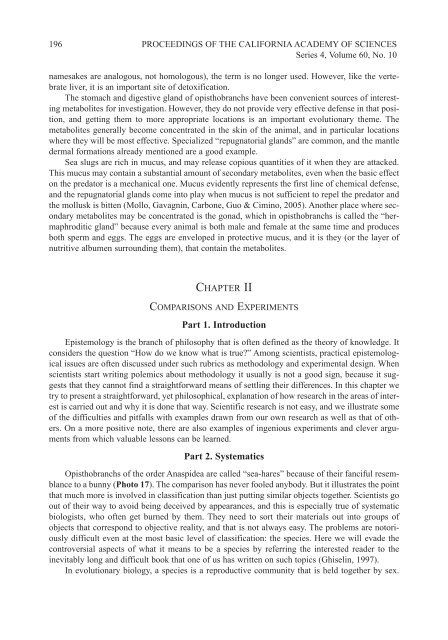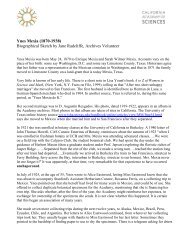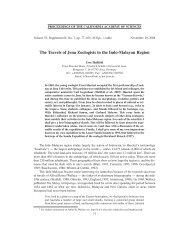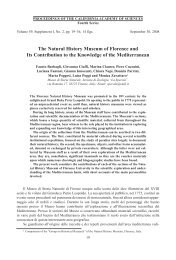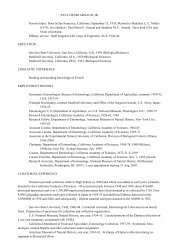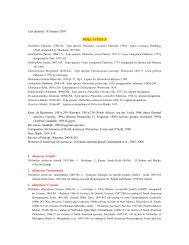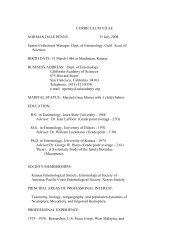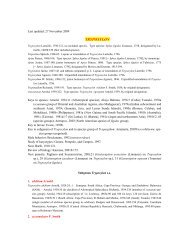Cimino&Ghiselin-tmpZXYZ:Template Proceedings_1.qxd.qxd
Cimino&Ghiselin-tmpZXYZ:Template Proceedings_1.qxd.qxd
Cimino&Ghiselin-tmpZXYZ:Template Proceedings_1.qxd.qxd
Create successful ePaper yourself
Turn your PDF publications into a flip-book with our unique Google optimized e-Paper software.
196 PROCEEDINGS OF THE CALIFORNIA ACADEMY OF SCIENCES<br />
Series 4, Volume 60, No. 10<br />
namesakes are analogous, not homologous), the term is no longer used. However, like the vertebrate<br />
liver, it is an important site of detoxification.<br />
The stomach and digestive gland of opisthobranchs have been convenient sources of interesting<br />
metabolites for investigation. However, they do not provide very effective defense in that position,<br />
and getting them to more appropriate locations is an important evolutionary theme. The<br />
metabolites generally become concentrated in the skin of the animal, and in particular locations<br />
where they will be most effective. Specialized “repugnatorial glands” are common, and the mantle<br />
dermal formations already mentioned are a good example.<br />
Sea slugs are rich in mucus, and may release copious quantities of it when they are attacked.<br />
This mucus may contain a substantial amount of secondary metabolites, even when the basic effect<br />
on the predator is a mechanical one. Mucus evidently represents the first line of chemical defense,<br />
and the repugnatorial glands come into play when mucus is not sufficient to repel the predator and<br />
the mollusk is bitten (Mollo, Gavagnin, Carbone, Guo & Cimino, 2005). Another place where secondary<br />
metabolites may be concentrated is the gonad, which in opisthobranchs is called the “hermaphroditic<br />
gland” because every animal is both male and female at the same time and produces<br />
both sperm and eggs. The eggs are enveloped in protective mucus, and it is they (or the layer of<br />
nutritive albumen surrounding them), that contain the metabolites.<br />
CHAPTER II<br />
COMPARISONS AND EXPERIMENTS<br />
Part 1. Introduction<br />
Epistemology is the branch of philosophy that is often defined as the theory of knowledge. It<br />
considers the question “How do we know what is true?” Among scientists, practical epistemological<br />
issues are often discussed under such rubrics as methodology and experimental design. When<br />
scientists start writing polemics about methodology it usually is not a good sign, because it suggests<br />
that they cannot find a straightforward means of settling their differences. In this chapter we<br />
try to present a straightforward, yet philosophical, explanation of how research in the areas of interest<br />
is carried out and why it is done that way. Scientific research is not easy, and we illustrate some<br />
of the difficulties and pitfalls with examples drawn from our own research as well as that of others.<br />
On a more positive note, there are also examples of ingenious experiments and clever arguments<br />
from which valuable lessons can be learned.<br />
Part 2. Systematics<br />
Opisthobranchs of the order Anaspidea are called “sea-hares” because of their fanciful resemblance<br />
to a bunny (Photo 17). The comparison has never fooled anybody. But it illustrates the point<br />
that much more is involved in classification than just putting similar objects together. Scientists go<br />
out of their way to avoid being deceived by appearances, and this is especially true of systematic<br />
biologists, who often get burned by them. They need to sort their materials out into groups of<br />
objects that correspond to objective reality, and that is not always easy. The problems are notoriously<br />
difficult even at the most basic level of classification: the species. Here we will evade the<br />
controversial aspects of what it means to be a species by referring the interested reader to the<br />
inevitably long and difficult book that one of us has written on such topics (<strong>Ghiselin</strong>, 1997).<br />
In evolutionary biology, a species is a reproductive community that is held together by sex.


